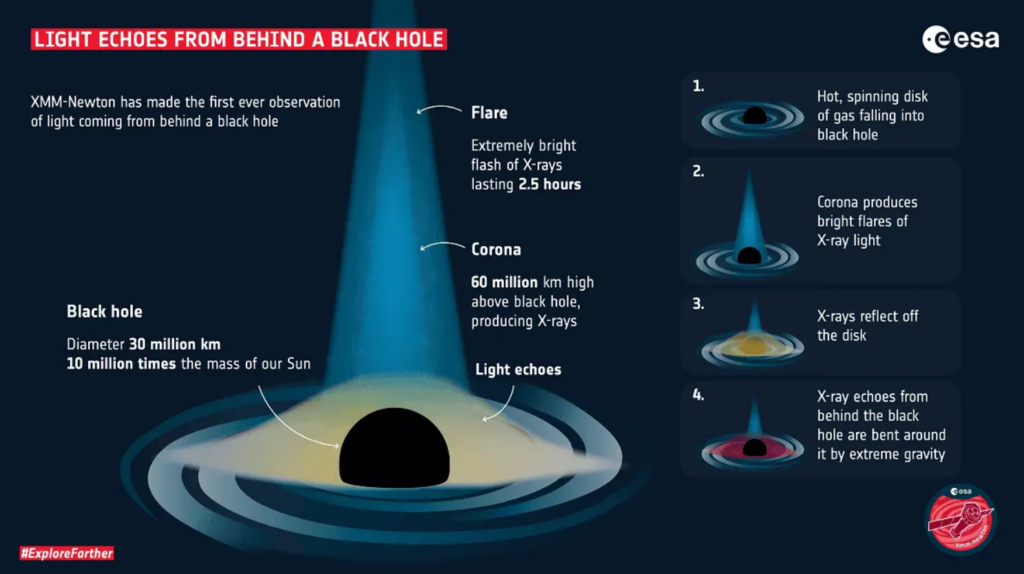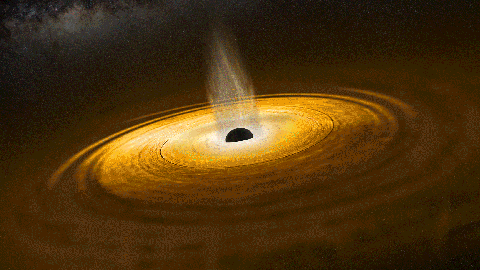Einstein’s theory once again validated as light detected from behind a black hole for the first time.
Maybe you have heard that neither darkness nor the light ray can ever leave the black hole, though this is not exactly an accurate statement. The event horizon is always losing something, but the X-rays from the hot disc of matter circling the black hole can be seen from Earth with a lot of power.
Not all of this light is thrown upwards during its journey across the galaxy.
While Dan Wilkins, an astrophysicist at Stanford University, was observing extra-X-ray leaps with the X-rays that were surfacing from a supermassive black hole in a galaxy placed 800 million light-years away, he revealed some anomalies. They sounded like they were from the past; they were smaller, appeared later, and had wavelengths different from the usual brighter emissions.
In their analysis, Wilkins and teammembers reported that the above-mentioned bright flashes seem to result from an inexplicable light source behind the black hole.
Wilkins says, “No light should be able to go into that black hole and get out or to be able to see behind the black hole because of its sheer enormity and mightiness. ”
“That is why we can see that, as that black hole is warping space, it is bending light and twisting magnetic fields around itself. ”
Similarly, black-hole’s enormous magnetic field, which spirals very high aboven their axis, as the black hole creates a tornado-like vortex, becomes so knotted that the field lines snap.
“It is the magnetic field which is dragged in and starts to fluctuate (which causes the snapping into the black hole) and it is this process that the high energy electrons are produced which emit X rays,” says Wilkins.
Some of the X-rays that are struggling to get out of the black hole’s strong gravitational pull are finally pulled back, and then they are reflected off the back of the disc and into space. Wilkins and his team are the witnesses for these “reflecting the light behind the black hole by intense gravity” because some of the echoes from behind the black hole are gravitationally bent around it.
The researchers move forward with the findings from the previously published study where there was a discovery of the imprints of such reflected light from the back of a black hole. For the first time, they have also gotten to observe directly the light behind a black hole.

Furthermore, the general theory of relativity by Albert Einstein predicts the exacts things that observations have recorded.
Professor Michael Cowley from Queensland University of Technology, who not participated in research said that the mentioned hypothesis means that large objects can bend spacetime leaving light to move along the routes that are bent.
Arthur Eddington, an English astronomer, made the first experimental verification of this theory in 1919 when he observed light from the stars being bent around the Sun during a solar eclipse, according to Cowley.
Imaging the reflected signals both when they should appear and what they should look like can be made possible through consideration of the QPP effect.
This is in contrast to a direct gravity sensation felt in open space when it is possible to see the effect.
He says, “It is a process of separating out all the other emissions in this active and high-energy region the disc’s response to being lit up by the X-ray flares from the region above the black hole. The achievement of having such a well-defined signal is impressive.
Cowley agrees: “Keeping with this spirit, this new job is increasingly filling the gap between purely observational and theoretical studies of active supermassive black holes and providing us with some important clues as to how they manage to harness such great amounts of power. ”
Astronomers can now learn more about how black holes work and how they produce such innumerable signals through intense observations.
The paper reveals, as per Eric Thrane of Monash University and OzGrav, a very interesting fact that the researchers are able to study the environment around a black hole that is devouring hot gas.
They notice that it is always exciting because it constantly changes. They feel stimulated from so varied experience. Placing the habit of using this data helped them define the black hole’s mass and the behavior of the gas surrounding it.
The formation process of the biggest black holes in the universe is one of the most intriguing mysteries of the universe. I am hoping that further studies in this field might someday bring about complete clarifications in accumulating black holes across cosmic time.
Do not forget to share your opinion with us to provide you with the best posts !




0 Comments